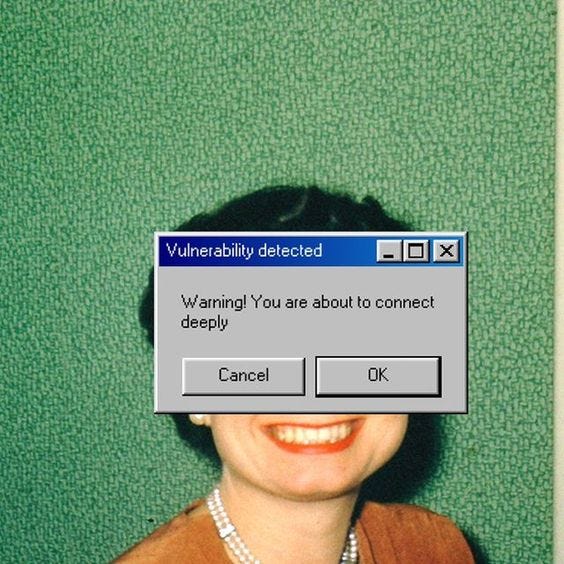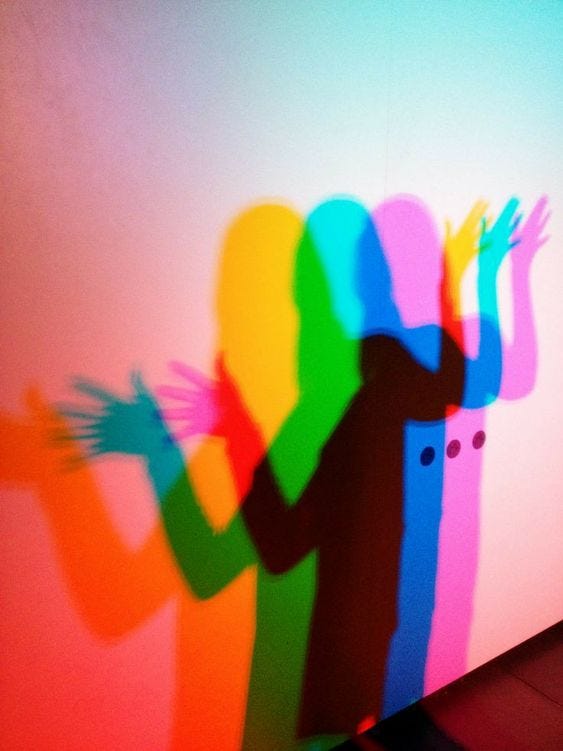Is Your Authenticity Suffocating?
Overcoming Mindsets That Keep You From Amplifying Your Authenticity
Can you remember the first time your face burned from embarrassment? The first time you realized you weren’t in on the joke? The first time you realized you’d shared too much as you watched the other person’s eyes change, or worse, felt them completely disengage?
The first time I remember crippling self-consciousness was after my parents divorced and I was desperate to look the part of what I saw as my unburdened, wealthy peers. To feel like I was wanted, I was safe, I was good enough, and I belonged. There was a lot of change, and a lot of loss, very quickly, and I felt the confidence I had as a small child slip through my fingers.
In middle school, I was changing after gym, and a girl came over and started talking about how gross it is when people wear the same clothes over and over. Happy to be included and feel normal, I nodded, smiled, and agreed with her “oh yeah totally!” - not realizing until she walked away laughing that it was me, it was my clothes I tried so hard to make look new she was making fun of. Of course, I’ve had worse things happen to me, but the reason this one matters is the type of shame it created.
Instead of being mad at her, I internalized the blame. Fool me once, shame on you - except I’ll carry the shame around for you. I had failed to see the signs, and I had failed to protect myself. And I would resist being fully myself for another 20 years after.
Hypervigilance and self-protection are built brick by brick through these types of experiences, suffocating authenticity. Hiding who you are is a learned behavior. Amplifying your authenticity is about unlearning these behaviors by examining the mindsets that reinforce them.


Mindsets That Suffocate Authenticity
The mindsets that suffocate authenticity often stem from these early experiences of shame, rejection, and self-doubt. Over time, you learn to protect yourself by adopting beliefs that keep you small and guarded, rather than open and genuine. To amplify your authenticity, you’ll need to identify and break free from what you built as a shield that is now stifling your true expression.
Fear of Judgment: You worry that showing your true self will lead to criticism or rejection.
Inconsistent Personalities: You feel like you have to be different versions of yourself depending on who you are with.
Balancing Professionalism and Personality: You struggle to maintain professionalism while showing personal authenticity and finding the right balance between the two.
Fear of Vulnerability: You avoid authenticity because it feels like exposing weaknesses (or you experience vulnerability hangovers where you regret being too open after the fact).
Imposter Syndrome: You feel like your authentic self isn’t "good enough" compared to others.
Overthinking: You constantly second-guess what you share, making authenticity feel forced.
Comparing to Others: You feel like you need to mimic others to be liked, rather than embracing your own uniqueness.
Strategies to Overcome These Mindsets and Amplify Your Authenticity
Over my life, I’ve set down many shields that were no longer serving me, but it was never by accident. When I first became a group fitness coach, I quickly realized my fear of judgment, fear of vulnerability, and comparing myself to others was preventing me from being the most impactful version of myself. When I was climbing the corporate ladder, I saw how being afraid to be “too” authentic was holding me back from being the type of leader I knew was actually needed. Overcoming these mindsets took more than just self-awareness - it took deliberate, actionable strategies. And it completely changed my life.
No matter what your unique set of challenges is, they can be met with the right approach. Below are some of my favorite strategies to help break down these barriers and start living more authentically.
1. Fear of Judgment
Create a 'Worst Case Scenario' Journal
Write down the absolute worst outcome you’re afraid of if you reveal your true self. Now dig deeper. Is this a legitimate safety issue to be afraid of, or is it really going to matter in a week? A year? This is a powerful process for reducing fear because it exposes the unrealistic severity of what you imagine judgment will be.
2. Inconsistent Personalities
Craft Your 'Core Values' Statement
Identify 3-5 core values that matter to you across all situations. Use these values as a touchstone for all your interactions, no matter who you’re with, to help align your actions with a consistent, authentic foundation.
3. Balancing Professionalism and Personality
Define Your 'Voice' in Professional Settings
Think of how you show up at work as a voice, kind of like a personal brand. Your brand may not include every single thing about you, but it should still be an authentic and aligned representation. For example, you can be personable and kind without oversharing every detail of your life. You can be authoritative without being cold or stiff. Think about what traits you want to bring into the professional setting and how your ‘voice’ represents them. The key is to not manufacture traits that are inauthentic and unaligned, or suppress traits that are vital to your core values.
4. Fear of Vulnerability
Practice ‘Micro-Authenticity’
Start by sharing small, genuine thoughts or moments once a day instead of going all in at once. This helps ease into authenticity without overwhelming fear of judgment.
5. Imposter Syndrome
Start a 'Micro-Wins' Log
Document even your smallest achievements and moments where being your authentic self brought success or connection. Over time, this builds a bank of proof that you are good enough and capable, helping to combat imposter syndrome.
Turn Your Inner Critic Into Your Guide
Create a “mentor” version of your inner critic. What would that critic say if they were helping you improve, instead of tearing you down? This reframes imposter syndrome as a growth opportunity.
6. Overthinking
Set a 5-Minute Rule
Post or share something authentic without overthinking it for more than 5 minutes. If you hide parts of yourself (maybe only sharing with ‘close’ friends), ask yourself why. What would happen if you shared it openly? The goal is to stop the habit of overanalyzing and start building confidence in spontaneous authenticity.
7. Comparing to Others
Embrace 'Anti-Inspiration' Days
Take a day each week to avoid social media, influencer content, or anything that feeds comparison. During this time, focus on creating or doing things that come from your own personal joy or skillsets.
Create a ‘Uniqueness List’
Write down 10 things that make you unique: quirks, life experiences, and perspectives. When tempted to compare, refer back to this list to remind yourself what sets you apart.
Reclaiming your authenticity is a process of unlearning the protective habits and mindsets that have kept you from fully expressing who you are. It’s about recognizing the experiences that shaped those shields and choosing to dismantle them, brick by brick. By using intentional strategies to overcome fear, comparison, and self-doubt, you can start showing up as the most genuine version of yourself. Remember, authenticity isn’t a destination - it’s an ongoing practice of self-acceptance and courage, allowing you to connect more deeply with others and, most importantly, with yourself.
Want to go deeper? Learn about ways to work with me.
Takeaways + Tools + Prompts
Authenticity is fluid, not fixed: It's okay for your authentic self to evolve over time. What feels true to you today may change, and that's a natural part of growth.
Boundaries boost authenticity: Being authentic doesn’t mean sharing everything. Setting clear boundaries can actually help you feel more secure in expressing the parts of yourself that matter most.
Vulnerability invites connection: While it may feel risky, showing vulnerability can deepen relationships and foster genuine connection. Start small and watch how people respond to the real you.
Perfection is the enemy of authenticity: Striving to be "perfect" often stifles your authentic self. Embrace imperfection as a part of what makes you unique and relatable.
Celebrate your quirks: The traits you may see as flaws or oddities are often what set you apart and make you memorable.
Meditative Prompt
Take a deep breath and close your eyes. As you exhale, imagine all the layers of fear, judgment, and self-doubt slowly peeling away, like old armor no longer serving you. Visualize your authentic self - raw, unapologetic, and free - emerging with every breath. Ask yourself: what part of me have I been hiding, and how can I gently begin to let it show today?
Creative Project Prompt
Used mixed media or collage to create two masks - one that represents how you present yourself to the world, and another that represents your truest, inner self. Use the opportunity to highlight the contrasts and connections between the two.
Gratitude Prompt
Consider writing these out by hand in your own words and saying them out loud:
I’m grateful for the experiences that have shaped me, even the painful ones, because they’ve taught me the importance of embracing my true self.
I’m grateful for the strength to challenge the mindsets that once held me back and for the courage to show up authentically each day.
I’m grateful for the uniqueness within me, knowing that my authenticity is a gift that connects me more deeply with others and myself.



This is so true! I think fear of judgement or criticism has also caused me to be afraid of taking risks. Moments when I've been able to try new things without worrying about what others might think, feels very liberating.